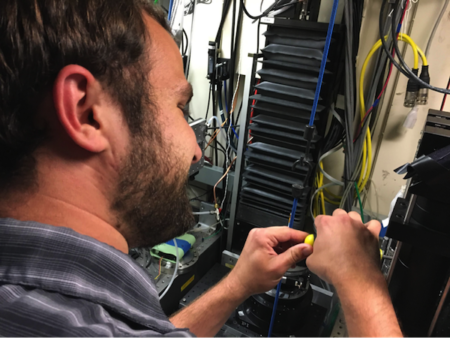By Ina Reichel
High school and undergraduate students don’t usually get a lot of real-world programming and hardware development experience, especially not with things like neural networks and synchrotron light source beamline components. Kara Levy, a recent graduate of Las Lomas High School in Walnut Creek, California, and Ryan Funchess, a mechanical engineering major at Cal Poly San Luis Obispo, were two of 18 students who got thrown into the deep end during their internships at the Advanced Light Source (ALS).
Levy first wrote a Python script producing Gaussian random fields to simulate the structure of thin films as well as their simulated scattering patterns. She then worked with a convolutional neural network—a machine-learning method often used for analyzing images—to investigate various scientific challenges at the ALS.
Gaining experience in understanding the applications of Python made Levy curious to learn more. “I wasn’t familiar with any of the scientific Python modules whatsoever, and frankly I wasn’t very knowledgeable or really aware of a lot of the uses of x-rays,” said Levy. “I’m totally going to keep up with those going forward.”

Funchess worked on three different components for Beamline 8.3.2. One was designing and building a new white-light optics assembly that promises to be more stable, reducing realignment requirements. It also allows for lens removal for bleaching and is designed to be as compact as possible. He also designed a beam-position monitor that will make the beamline assembly more adjustable. Lastly, Funchess designed an upgraded thermal tensioner that will allow 3D imaging of samples that are undergoing failure under tension at temperatures up to 1500 °C. Upgrades over the previous tensioner include an increase in load capacity and the space available for the sample.
“The ability to take what you’ve learned in school and actually see it happen in front of you is pretty cool,” Funchess said. “I went from developing a solid model, through all the steps of the design process, and ended up with something I can hold in my hands.”
The interns were mentored by several ALS staff from the Photon Science Group, including Alex Hexemer, Alastair MacDowell, Cheng Wang, Dula Parkinson, Dylan McReynolds, and Harold Barnard, and worked at Beamlines 7.3.3, 8.3.2, and 11.0.1.2. With so many interns, the mentors decided to pool resources and mentor them as a group. To encourage them to work together, they set up a number of activities for them to get to know each other but also for them to learn more about Berkeley Lab and the ALS, including weekly group meetings and a “meet people at the ALS” series. In their weekly meetings they used the Scrum process, a project management framework that focuses on iteration and feedback, to make sure the interns did not get side-tracked by a minor problem and to get them talking to one another and their mentors more.
The outcomes of Levy’s and Funchess’s experiences were exactly what mentor McReynolds had hoped. “I really wanted them to get immersed in the ALS as well as try to actually get some real software developed—things that people would actually use,” he said.
Levy and Funchess both hope to return to the Lab and the ALS.
“Everyone here is always doing something truly, truly fascinating,” Levy said. “So I think even to come back just to talk to a few scientists would be a fun experience, if not to work here.”
Funchess echoed a similar sentiment. “I think particle accelerator technology, everything that’s happening at the Lab is pretty cutting edge,” he said. “I’d love to get my hands involved with cool stuff in the future.”
